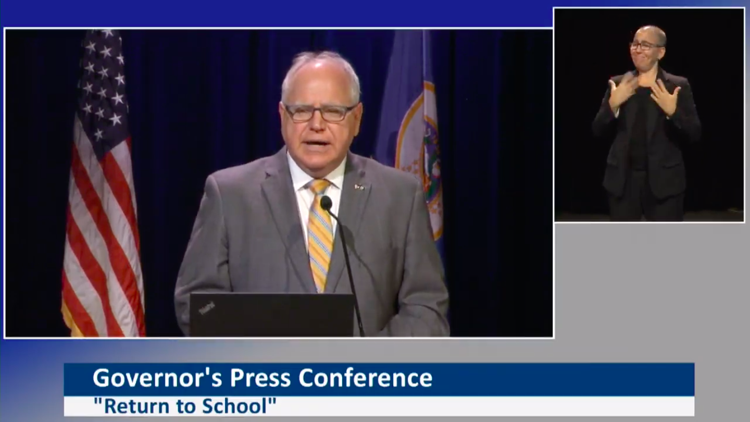Walz announces districts will choose their learning method for the fall

Gov. Tim Walz announces Minnesota’s return to learn plan on July 30, 2020.
(The Center Square) – Gov. Tim Walz on Thursday announced Minnesota’s Safe Learning Plan, which details when school districts and charter schools can begin school in-person, in distance learning, or in a hybrid model depending on local data.
The Minnesota Department of Education (MDE) and the Minnesota Department of Health (MDH) will advise local schools which model the school should start in depending on COVID-19 activity in that county.
“As a classroom teacher for more than 20 years and a parent of a child in public schools, I am committed to providing a world-class education to our students while keeping them and their teachers safe,” Walz said in a statement.
“With this approach, we are pairing the knowledge and data from our Departments of Health and Education with the expertise of our local school districts to make the best decisions for our students across the state.”
Each local school district will then choose its learning model.
These guidelines don’t govern private schools, but the state will provide masks to them.
The learning model recommendation is based on this formula: The total number of COVID-19 cases in the county for the last 14 days, divided by the county population divided by 10,000.
That gives the 14-day county case level rate per 10,000.
- If that number is less than 10: in-person learning
- 10-20: in-person elementary, hybrid secondary
- 20-30: hybrid for both
- 30-50: hybrid elementary, distance secondary
- 50+: distance for all
“This guidance isn’t drawn in stone,” Walz said.
Using current data, the recommendations would be:
- 181 districts start with in-person learning
- 230 districts start with in-person elementary with hybrid learning for secondary
- 107 districts start with hybrid learning for elementary and secondary
- 7 districts start with hybrid for elementary, and distance learning for secondary
- 9 districts start with distance learning for elementary and secondary
MDE and MDH will work with school districts and local health professionals to help districts decide if they need to switch learning models.
The plan prioritizes keeping younger children in the classroom since transmission is less likely for younger children and in-person learning is critical at that age.
The Centers for Disease Control and Prevention (CDC), as of July 17, 2020, reported that those under 18 years old account for under 7 percent of COVID-19 cases and less than 0.1 percent of coronavirus deaths.
The plan requires school districts and charter schools to allow families to choose to learn remotely even if the district chooses in-person learning.
School districts must allow teachers and employees to work remotely as much as possible.
“The health and safety of our students, educators, school staff, and families are our number one priority,” MDE Commissioner Mary Cathryn Ricker said in a statement.
“This localized approach that is centered on the data and informed by a school’s ability to follow all the public health requirements, will help school districts and charter schools navigate this uncertain school year.”
MDH Commissioner Jan Malcolm said it’s hard to predict how COVID-19 will impact schools this fall.
“It is important for the well-being of Minnesota children that we get this right, and that we have solid and flexible plans in place to adapt to the COVID-19 challenge,” Malcolm said in a statement.
Minnesota House Speaker Melissa Hortman, DFL-Brooklyn Park, called the plan “reasonable” in a statement.
She added: “Our students deserve the best possible learning environment, taking into account the difficult circumstances we face,” she added. “If it is safe for students, their families, and educators, we all would like to see students in the classroom.”

